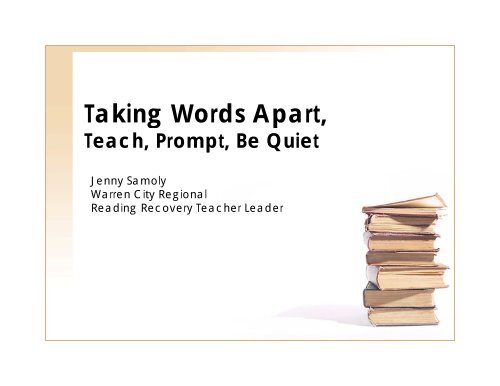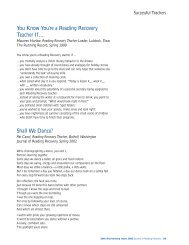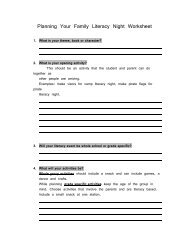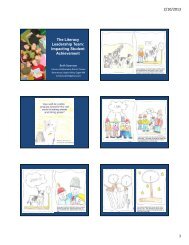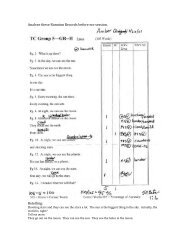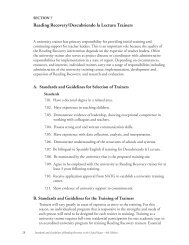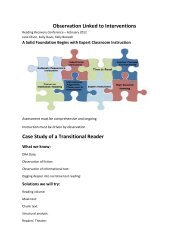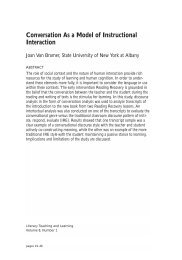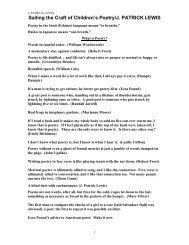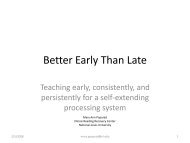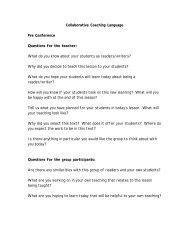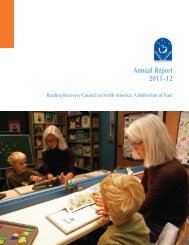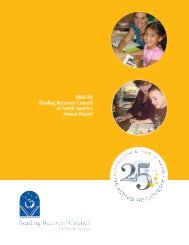Jennifer Samoly - Taking Words Apart: Teach, Prompt, Be Quiet
Jennifer Samoly - Taking Words Apart: Teach, Prompt, Be Quiet
Jennifer Samoly - Taking Words Apart: Teach, Prompt, Be Quiet
- No tags were found...
You also want an ePaper? Increase the reach of your titles
YUMPU automatically turns print PDFs into web optimized ePapers that Google loves.
<strong>Taking</strong> <strong>Words</strong> <strong>Apart</strong>,<strong>Teach</strong>, <strong>Prompt</strong>, <strong>Be</strong> <strong>Quiet</strong>Jenny <strong>Samoly</strong>Warren City RegionalReading Recovery <strong>Teach</strong>er Leader
• <strong>Be</strong>tsy Kaye’s research• LLDI 1: Changes teacher mightobserve during lessons• LLDI 2: Chapter One; Learning tolook at print• LLDI 2: Section Ten; Finding andusing the information in the print:developing the brain’s activitieson texts• LLDI 2: Section 12; <strong>Taking</strong> wordsapart while reading
Goals of the Session• To learn what to expectwhen• To learn how to teachtaking words apart• To learn the promptsthat promote takingwords apart• To learn to stay quiet
WARNING WARNING WARNING
Take <strong>Words</strong> <strong>Apart</strong>ONLYWhen Necessary• <strong>Teach</strong> when it isimportant t for aparticular child –andnot as a matter ofroutine.
Clay states that reading is amessage getting, problemsolving activity.
WARNING WARNING WARNING
Make interactions briefand to the point
Talk about words the childknows, or is working on; notonly the ‘new’ words.
Do not do itbecause it mighthelp in the future;only because it isneeded at this timein his learning.LLDI 2 136
Every teachingmove should oud bringseveral gains andthe teacher shouldaim for higher goalsthan mere repetitionor practice.Clay, 2001, pg. 174
“Competent t treaders…use manydifferent ways ofbreaking to solve newwords.”Clay, (2005b) p. 131
<strong>Be</strong>tsy Kaye’sSecond Graders’ Reading<strong>Be</strong>haviors:A Study of Variety, Complexity,And Change• Literacy <strong>Teach</strong>ing andLearning: An InternationalJournal of Early Readingand Writing, 10(2), 51-75
Second grade readers…
Used a variety of ways to solve• Said the first consonantcluster or sound of theword and then said thewhole word.w-washer• Said the first part, thenstarted over and said thewhole word.int-interesting
• Said the first part of theword and then the restdr-ied• Made four or moreattempts using a varietyof word parts and/orwhole wordscon, con, cunny,continueted forcontinued
• Tried the first part of theword two different waysand then started over andsaid the whole worddis, diseye, disease• Made consecutivesubstitutionshid, heard, head for head
• Divided the word into threeor more partsin-hab-i- tents
Showed consistency in solving• Never attempted letterby letter sounding out• Never skipped a wordand read to the end• Never appealed forhelp before trying• Never just stopped
• When the child’s series oflessons ends and he is readinga text of appropriate level heshould be able to solve amultisyllabic word (one that isnew, not yet familiar, orunexpected) within continuoustext without slowing up tomuch, and by working flexiblywith word parts and clusters ofletters from an awareness ofhow words work.LLDI 2, 156
The Two Journeys:The beginning reader isa long way from havinganything under perfectcontrol, and each thingthat the child is learningabout…is on a leasttwo journeys:
• A) one of coming toknow…and thenregrouping some ofthis in some unitisedchunks,
• B) responding to itfaster and faster withminimal i attentiontiunless a detail is atask requirement.Clay, 2001, p. 175
Fast Processing is important
WARNING WARNING WARNING
The following should notbe seen as stages, butrather as a need forteachers “to adjust theirexpectations andinteractions during thelesson series accordingto the progress of eachlearner”.LLDI 1, 48
First LearningEarly LearningMid LearningLate Learning
First Learning – levels 1 & 2glearning how print works
Fast Processing is important• At no time in theReading Recoverylesson series shouldthe child be a slowreader of the thingshe knows.LLDI 2, 151
Levels els 1 & 2• Directional movement• 1-1 match• Differentiate print frompictures• Use information frompictures and simplelanguage structures to‘read’•Ø TWA
Early Learning – levels 3 - 5/6learning how to look at print
Fast Processing is important• Encourage the childto engage in fastrecognition and tryto bring new learningto a level of fastresponding asquickly as possible.LLDI, 2 154
Levels els 3 – 5/6• Locating known words• Locating unknown words• Learning ways toremember wordsLLDI, 2 106-107107• Learning to attend visually• Learning to attend visuallyto print
• Breaks apart known words(from reading or writing)into letters and identifiessome of these.• The child is learning thatletter order and letterorientation are important.LLDI, 1 49
<strong>Teach</strong><strong>Taking</strong> <strong>Words</strong> <strong>Apart</strong>• Draw Attention to first letters• Final letters, signs, andinflections• Prepare for sometimeshearing chunks ofinformation: hearing thebreaks between groups oflettersLLDI, 2 129-131
Breaking Letters out of <strong>Words</strong> (19)• Demonstrate withdeliberate movementsbreaking letters, slidingthem from first to last–Above– Or below– Or to his left
I can take words apart #1 (42)• Build a carefully chosenword letter by letter, left toright.• Say, If we were going towrite this word we wouldhave to make it letter byletter.• Use known words at first;you are teaching how todo this.
I can take words apart #2 (43)• Add on a final inflection likeplural ‘s’ or verb ending like‘ing’.• Choose a word of one syllableplus an inflection from aprevious text context.• What’s the first letter in ‘look’• Can you hear the last part of‘looking’?• We can take the first part away(to the left). look ing
I can take words apart #3 (44)• Demonstrate breaking a knownword of one syllable• Build the word ‘went’ and verydeliberately pull the ‘w’towards to left leaving the ‘ent’on the right.• Move the ‘ent’ across tocomplete the word.• Ask the child to break the wordinto two part.• The child may make the breakanywhere as long as he getstwo parts.
Hearing syllables (72)• Ask the child to clap theparts he can hear in a fewtwo- or three-syllable wordshe knows well…and laterthree or four.• Repeat this activity asopportunities arise.• The activity will help withthe multisyllabic words ofhiger-level reading books.
<strong>Teach</strong> and <strong>Prompt</strong><strong>Taking</strong> <strong>Words</strong> <strong>Apart</strong>• It looks like the firstletter in your name.• That sounds like thebeginning of Jake.• Do you think it lookslike ‘went’?• Can you hear thisletter?
• You said… was that right?• Read up to the problemword od fluently and stop, sop,expecting him to finish thereading. Or read fluentlyand articulate the firstletter of the problem word.LLDI 2 106-1070
<strong>Teach</strong> on an unknown n word• A WeekwithAunt<strong>Be</strong>a:Trevor
<strong>Teach</strong> on correct responding• Our dogSam:Cyndle
Remember:• Early learning is allabout exposure andbecoming familiar withlearning how to look.
Mid Learning - levels 5/6 – 11/12g / /learning to take action
Fast Processing is important• By the middle of alesson series theteacher canencourage phrasedreading even onnew material.LLDI 2, 157
Levels els 5/6 – 11/12• Self-monitoring• Cross-checking• Searching• Self-correcting•ConfirmingLLDI 2 108-113
<strong>Teach</strong><strong>Taking</strong> <strong>Words</strong> <strong>Apart</strong>• Syllable break• Inflection break• Prefix and suffixbreak• Onset and rimebreakLLDI 2 131
• Breaks words intosingle letters, or intoclusters, or intoonsets and rimes,and into largerchunks.
– Moves left to right insequence across letters inwords– Looks at the root, breaks off(or adds) final inflections– Learning to take off firstletters, or clusters ofconsonants (onsets, andfinds them in other words– Later, can take the rimeaway from the onset
• The child notices thatthe same letters orclusters are found indifferent words, andso can begin to useanalogy.LLDI 1 49
Warning, Warning, Warning• It is risky to try to teachchildren to use analogyunless you are watchingcarefully.• Watch carefully how theythemselves analyse orconstruct, before youintervene with ‘teaching’.LLDI 2 134
Cumulative Analysis•Write LxL•MLs• Reread up to the pointsspspl - ash!
<strong>Prompt</strong><strong>Taking</strong> <strong>Words</strong> <strong>Apart</strong>• Do you know a wordthat starts with thoseletters?• Look for somethingthat would help you.• What can you see thatmight help?
• Do you know a wordthat looks like that?• What can you hearthat might help?• Look carefully and thinkwhat you know thatmight help.LLDI 2 111 & 132
A scale of help while reading( 132-133)Moving from most help to least
<strong>Teach</strong>, <strong>Prompt</strong>, and <strong>Be</strong> <strong>Quiet</strong>
<strong>Teach</strong>• The teacher articulates thepart clearly (a hearingprompt) and the childlocates the part.• The teacher divides theword in print with finger ormasking card.• The teacher constructspart of the word making itlarger in some ‘grandmanner’.
<strong>Prompt</strong>• <strong>Prompt</strong> to the childbeginning (initial letter,onset, cluster) or to theending (inflection or rimeor to any known part).• The teacher articulates thepart clearly (a hearingprompt) and the childlocates the part.
<strong>Be</strong> <strong>Quiet</strong>• Let the child solvethe word.• The child divides id the wordwith his finger on print oruses a card to mask it insome way.
Another way to look at it:• The Scale of Knowing
• New?• Only just known?• Successfully yproblem solved?• Easily produced but easily thrown?
• Well-known?• Known in many variant forms?
Say a little more• The HungryGiant:Zane
After the Running Record• I’m Telling:Zane
Remember:• Mid-learning is all abouttaking action ANDaction does not alwayslead to correctresponding.
Later Learning – levels 12 +on the run
Accountability at the higherlevels:• More noticing• More fixing• More solving• More accountablefor close accuracy
• The goal of all forms ofword analysis for thereader is to be able to takewords apart, on the runwhile reading– Unexpected known words,– Partially familiar words stillbeing learned– And new, unknown words.LLDI 2 132
The reader must build towardsa self-extending system.• Children solve newchallenges includingmultisyllabic wordswithin more difficulttexts at speed, workingwith clusters of lettersLLDI 1 51
• Good readers didnot limit themselvesto a narrow range ofways to solvechallenges inreading.LLDI 2 137
What is this word?• The Lionand theMouse:Zane
On the way to independence• Just thisOnceZane
Remember:• Later learning is aboutmaintaining meaning,attending to visualinformation, and using allsources of informationflexibly,fast f and efficiently.i
<strong>Teach</strong>
<strong>Prompt</strong>
<strong>Be</strong> <strong>Quiet</strong>


